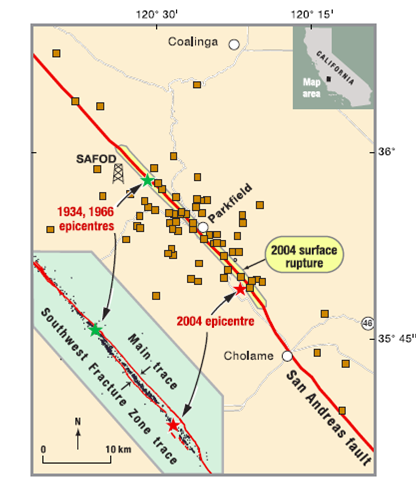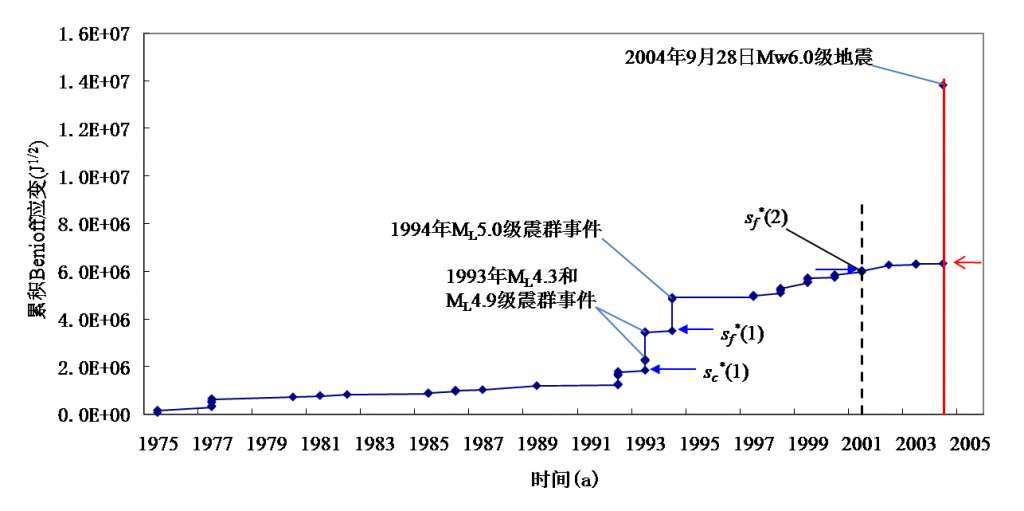博文
为何预期中的Parkfield 6.0级地震姗姗来迟?
|||
在San Andreas断层带上的Parkfield段,大约每隔22年会发生一次约为6.0级的地震[1-2],地震学家们认为是一个特征地震区。前几次地震分别发生在1857年、1881年、1901年、1922年、1934年和1966年,时间间隔分别为24年、20年、21年、12年和32年。只有1934年的地震发生提前了10年,但震级偏小。根据这一规律,Parkfield应于1988年发生一次6.0级地震,最迟也不应超过1993年。但直到2004年9月28日,等待了11年之久的6.0级地震(图1)才终于发生了。
震前沿该段布设了大量的观测仪器,以扑捉前兆异常、探索短临预报的可能性。但该地震出人预料的延迟发生及无显著性异常发现的事实,几乎催垮了美国地震学家的信心,以至于后来美国地震学家谈【地震预报】色变,认为【地震预报】没有可能实现。
为什么预期中的该地震姗姗来迟?地震学家对此百思不得其解。本文试图根据我们提出的孕震断层多锁固段脆性破裂理论和相关预测方法,探索并揭示这一科学之谜。

图1 2004年Parkfiled Mw6.0级地震震中位置
(小方块表示观测仪器的位置)[2]
由于该断层的孕震区域[2]明确,因此计算Benioff应变时搜索区域为一沿断层带的矩形区域,长度为实际地震发生后断层破裂长度,宽度为垂直断层走向两侧各20-40km(在此范围内取值都能得到同样的分析结果)。地震目录引自美国地震信息中心(NEIS)网站提供的数据,数据时段为1975年到2004年9月28日主震发生的时间范围内的所有事件。
从图2知,经误差修正后,根据1993年ML4.9级震群事件起点对应的CBS值,可预测到1994年ML5.0级地震对应的临界CBS值;同理,再根据5.0级震群事件,预测下一次6.0级地震的CBS临界值为5.961E+06(J1/2),而实际发生值为6.333 E+06(J1/2)(红色箭头表示),相差0.372+06(J1/2)。从换算到对应的时间上看,预测该6.0级地震发生时间为2001年11月26日,比实际发震时间提前约2年零11个月。尽管时间误差较大,但对该6.0级地震的预测而言,这已是最好的结果了。

图2 1975.5.1~2004.9.28期间观测的沿San Andreas断层Parkfileld段累积Benioff应变曲线
(垂直虚线与红线分别表示预测与实际的主震发生时间)。
误差修正已被考虑。
对该震例的回溯性预测分析表明,强震可以预测,但由于强震孕育过程的缓慢性、观测数据误差的不可避免性,尽管预测的CBS临界值和实际值相差较小,但对应到时间上仍会有较大误差。
扯远了,再回到主题上。由以上分析知,实际上预期中的1993年地震事件已经发生了,但不是震级为6.0的事件,而是最大震级为4.9级的事件。由于第二锁固段的存在,其损伤积累到临界状态需要时间过程,这使得预期中的6.0级事件姗姗来迟。这表明,即使是特征地震区,【地震们】也是诡计多端,根据复发时间判断下一次事件的发生并不靠谱。以后怎么办?只有依靠科学的预测方法和长期的监测才能解决之。
参考
[1] Lubick N. 帕克菲尔德最终还是震了.国际地震动态,2005,No.2.[2] Bakun W H,, Aagaard B, Dost B, et al. Implications for prediction and hazard assessment from the 2004 Parkfield earthquake. Nature, 2005, 473: 969~974.
监测情况:
In the mid 1980s the USGS and several California universities initiated an intensive seismic monitoring program at Parkfield. The program now includes the following instrumentation:
12 creep meters (to measure slow aseismic slip on the fault) |
2 electronic distance measurement instruments (to monitor displacement) |
12 GPS stations (to monitor displacement) |
8 dilatational strain meters (to assess strain build-up in rocks) |
3 tensor strain meters (to assess strain build-up in rocks) |
12 short-period seismometers |
10 bore-hole seismometers |
30 strong motion sensors (to measure the ground motion associated with a large earthquake) |
a 2.2 km deep borehole with various instrumentation |
a proposed 4 km deep borehole with various instrumentation |
Amongst numerous other studies, earth scientists are monitoring water levels in wells and analyzing data from satellites to assess ongoing ground displacement.
https://blog.sciencenet.cn/blog-575926-678547.html
上一篇:谁能告诉我,深源地震的机制是什么?
下一篇:科学研究的误区【2】:有些东东无法得到证实